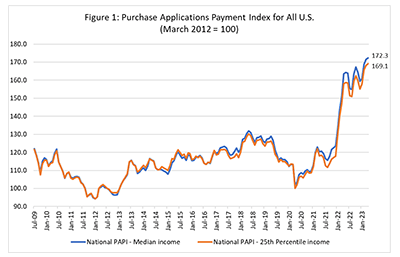
MBA: Mortgage Application Payments Increased 0.9% to $2,112 in April

Homebuyer affordability declined further in April, with the national median payment applied for by purchase applicants increasing 0.9 percent to $2,112, the Mortgage Bankers Association’s Purchase Applications Payment Index reported.
The MBA PAPI measures how new monthly mortgage payments vary across time–relative to income–using data from MBA’s Weekly Applications Survey.
“Homebuyer affordability eroded further in April, with both the typical borrower monthly payment and median purchase amount rising due to higher rates and home prices,” said Edward Seiler, MBA Associate Vice President of Housing Economics, and Executive Director of the Research Institute for Housing America. “Elevated interest rates and low housing supply have kept many prospective borrowers on the sidelines. However, MBA expects mortgage rates to stabilize and inventory levels to improve, which should incentivize some buyers to reenter the market.”
An increase in MBA’s PAPI–indicating declining borrower affordability conditions–means the mortgage payment to income ratio is higher due to increasing application loan amounts, rising mortgage rates or a decrease in earnings. A decrease in the PAPI–which indicates improving borrower affordability conditions–occurs when loan application amounts decrease, mortgage rates decrease, or earnings increase.
The national PAPI (Figure 1) increased 0.5 percent to 172.3 in April from 171.5 in March. The increase means that the PAPI hit a new record high last month. Compared to April 2022 (163.6), the index is up 5.3 percent. For borrowers applying for lower-payment mortgages (the 25th percentile), the national mortgage payment increased to $1,430 in April from $1,411 in March.
The Builders’ Purchase Application Payment Index (BPAPI) showed that the median mortgage payment for purchase mortgages from MBA’s Builder Application Survey decreased to $2,445 in April compared to $2,508 in March.
MBA’s national mortgage payment to rent ratio (MPRR) decreased from 1.45 at the end of the fourth quarter (December 2022) to 1.43 at the end of the first quarter (March 2023), meaning mortgage payments for home purchases have decreased relative to rents. The Census Bureau’s HVS national median asking rent in first-quarter 2023 increased 10.5 percent on a quarterly basis to $1,462 ($1,322 in fourth-quarter 2022). The 25th percentile mortgage application payment to median asking rent ratio remained essentially flat at 0.96 in March, (0.96 in December 2022).
Additional Key Findings of MBA’s Purchase Applications Payment Index (PAPI) – April 2023:
• The national median mortgage payment was $2,112 in April, up from $2,093 in March and from $2,061 in February. It is up $223 from one year ago, equal to an 11.8% increase.
• The national median mortgage payment for FHA loan applicants was $1,750 in April, down from $1,755 in March and up from $1,374 in April 2022.
• The national median mortgage payment for conventional loan applicants was $2,170, up from $2,145 in March and from $1,967 in April 2022.
• The top five states with the highest PAPI were: Idaho (255.6), Nevada (246.3), Arizona (226.1), Florida (216.6), and California (213.9).
• The top five states with the lowest PAPI were: North Dakota (116.4), Connecticut (124.4), Louisiana (129.3), West Virginia (131.9), and D.C. (133.5).
• Homebuyer affordability decreased for Black households, with the national PAPI increasing from 175.8 in March to 176.6 in April.
• Homebuyer affordability decreased for Hispanic households, with the national PAPI increasing from 160.2 in March to 161.0 in April.
• Homebuyer affordability decreased for White households, with the national PAPI increasing from 172.2 in March to 173.0 in April.
About MBA’s Purchase Applications Payment Index
The Mortgage Bankers Association’s Purchase Applications Payment Index measures how new mortgage payments vary across time relative to income. Higher index values indicate that the mortgage payment to income ratio is higher than in a month where the index is lower. Contrary to other affordability indexes that make multiple assumptions about mortgage underwriting criteria to estimate mortgage payment level, PAPI directly uses MBA’s Weekly Applications Survey data to calculate mortgage payments.
PAPI uses usual weekly earnings data from the U.S. Bureau of Labor Statistics’ Current Population Survey. Usual weekly earnings represent full-time wage and salary earnings before taxes and other deductions and include any overtime pay, commissions, or tips usually received. Note that data are not seasonally adjusted.
MBA’s Builders’ Purchase Application Payment Index uses MBA’s Builder Application Survey data to create an index that measures how new mortgage payments vary across time relative to income, with a focus exclusively on newly built single-family homes. As with PAPI, higher index values indicate that the mortgage payment to income ratio is higher than in a month where the index is lower. To create BPAPI, principal and interest payment amounts are deflated by the same earnings series as in PAPI.
The rent data series calculated for MBA’s national mortgage payment to rent ratio comes from the U.S. Census Bureau’s Housing Vacancies and Homeownership survey’s median asking rent. The HVS data is quarterly, and as such, the mortgage payment to rent ratio will be updated quarterly. Note: MPPR data is not included in this December 2022 release.
For additional information on MBA’s Purchase Applications Payment Index, click here.
